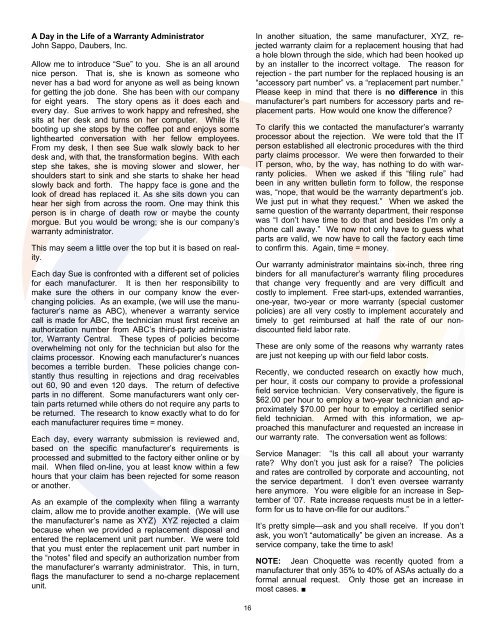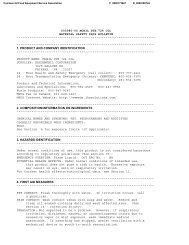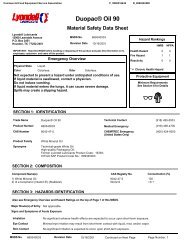On Target
mar april 2008.pub - CFESA
mar april 2008.pub - CFESA
- No tags were found...
Create successful ePaper yourself
Turn your PDF publications into a flip-book with our unique Google optimized e-Paper software.
A Day in the Life of a Warranty Administrator<br />
John Sappo, Daubers, Inc.<br />
Allow me to introduce “Sue” to you. She is an all around<br />
nice person. That is, she is known as someone who<br />
never has a bad word for anyone as well as being known<br />
for getting the job done. She has been with our company<br />
for eight years. The story opens as it does each and<br />
every day. Sue arrives to work happy and refreshed, she<br />
sits at her desk and turns on her computer. While it’s<br />
booting up she stops by the coffee pot and enjoys some<br />
lighthearted conversation with her fellow employees.<br />
From my desk, I then see Sue walk slowly back to her<br />
desk and, with that, the transformation begins. With each<br />
step she takes, she is moving slower and slower, her<br />
shoulders start to sink and she starts to shake her head<br />
slowly back and forth. The happy face is gone and the<br />
look of dread has replaced it. As she sits down you can<br />
hear her sigh from across the room. <strong>On</strong>e may think this<br />
person is in charge of death row or maybe the county<br />
morgue. But you would be wrong; she is our company’s<br />
warranty administrator.<br />
This may seem a little over the top but it is based on reality.<br />
Each day Sue is confronted with a different set of policies<br />
for each manufacturer. It is then her responsibility to<br />
make sure the others in our company know the everchanging<br />
policies. As an example, (we will use the manufacturer’s<br />
name as ABC), whenever a warranty service<br />
call is made for ABC, the technician must first receive an<br />
authorization number from ABC’s third-party administrator,<br />
Warranty Central. These types of policies become<br />
overwhelming not only for the technician but also for the<br />
claims processor. Knowing each manufacturer’s nuances<br />
becomes a terrible burden. These policies change constantly<br />
thus resulting in rejections and drag receivables<br />
out 60, 90 and even 120 days. The return of defective<br />
parts in no different. Some manufacturers want only certain<br />
parts returned while others do not require any parts to<br />
be returned. The research to know exactly what to do for<br />
each manufacturer requires time = money.<br />
Each day, every warranty submission is reviewed and,<br />
based on the specific manufacturer’s requirements is<br />
processed and submitted to the factory either online or by<br />
mail. When filed on-line, you at least know within a few<br />
hours that your claim has been rejected for some reason<br />
or another.<br />
As an example of the complexity when filing a warranty<br />
claim, allow me to provide another example. (We will use<br />
the manufacturer’s name as XYZ) XYZ rejected a claim<br />
because when we provided a replacement disposal and<br />
entered the replacement unit part number. We were told<br />
that you must enter the replacement unit part number in<br />
the “notes” filed and specify an authorization number from<br />
the manufacturer’s warranty administrator. This, in turn,<br />
flags the manufacturer to send a no-charge replacement<br />
unit.<br />
In another situation, the same manufacturer, XYZ, rejected<br />
warranty claim for a replacement housing that had<br />
a hole blown through the side, which had been hooked up<br />
by an installer to the incorrect voltage. The reason for<br />
rejection - the part number for the replaced housing is an<br />
“accessory part number” vs. a “replacement part number.”<br />
Please keep in mind that there is no difference in this<br />
manufacturer’s part numbers for accessory parts and replacement<br />
parts. How would one know the difference?<br />
To clarify this we contacted the manufacturer’s warranty<br />
processor about the rejection. We were told that the IT<br />
person established all electronic procedures with the third<br />
party claims processor. We were then forwarded to their<br />
IT person, who, by the way, has nothing to do with warranty<br />
policies. When we asked if this “filing rule” had<br />
been in any written bulletin form to follow, the response<br />
was, “nope, that would be the warranty department’s job.<br />
We just put in what they request.” When we asked the<br />
same question of the warranty department, their response<br />
was “I don’t have time to do that and besides I’m only a<br />
phone call away.” We now not only have to guess what<br />
parts are valid, we now have to call the factory each time<br />
to confirm this. Again, time = money.<br />
Our warranty administrator maintains six-inch, three ring<br />
binders for all manufacturer’s warranty filing procedures<br />
that change very frequently and are very difficult and<br />
costly to implement. Free start-ups, extended warranties,<br />
one-year, two-year or more warranty (special customer<br />
policies) are all very costly to implement accurately and<br />
timely to get reimbursed at half the rate of our nondiscounted<br />
field labor rate.<br />
These are only some of the reasons why warranty rates<br />
are just not keeping up with our field labor costs.<br />
Recently, we conducted research on exactly how much,<br />
per hour, it costs our company to provide a professional<br />
field service technician. Very conservatively, the figure is<br />
$62.00 per hour to employ a two-year technician and approximately<br />
$70.00 per hour to employ a certified senior<br />
field technician. Armed with this information, we approached<br />
this manufacturer and requested an increase in<br />
our warranty rate. The conversation went as follows:<br />
Service Manager: “Is this call all about your warranty<br />
rate? Why don’t you just ask for a raise? The policies<br />
and rates are controlled by corporate and accounting, not<br />
the service department. I don’t even oversee warranty<br />
here anymore. You were eligible for an increase in September<br />
of ‘07. Rate increase requests must be in a letterform<br />
for us to have on-file for our auditors.”<br />
It’s pretty simple—ask and you shall receive. If you don’t<br />
ask, you won’t “automatically” be given an increase. As a<br />
service company, take the time to ask!<br />
NOTE: Jean Choquette was recently quoted from a<br />
manufacturer that only 35% to 40% of ASAs actually do a<br />
formal annual request. <strong>On</strong>ly those get an increase in<br />
most cases. ■<br />
16








